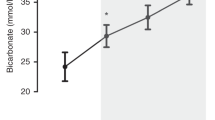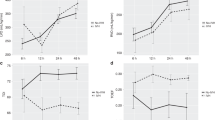Abstract
The effect of phenobarbital on cerebral blood flow (CBF) was investigated by the intravenous Xenon133 clearance technique in seven term newborn infants with signs of mild to moderate hypoxic ischaemic encephalopathy, all on sustained spontaneous ventilation. Phenobarbital treatment had no significant effect on CBF 60 min after loading dosage (20mg/kg i.v.). Likewise, no significant change in mean arterial blood pressure, heart rate or transcutaneous gas tensions was observed. Though slight changes in CBF of short duration cannot be excluded, conventional dosage of phenobarbital to term newborn infants with foetal distress apparently imposes no risk of cerebrovascular damage.
Similar content being viewed by others
Abbreviations
- CBF :
-
cerebral blood flow
- CMRO2 :
-
cerebral metabolic rate of oxygen
- HIE :
-
hypoxic ischaemic encephalopathy
- MABP :
-
mean arterial blood pressure
References
De Carolis MP, Muzii U, Romagnoli C, Zuppa AA, Zecca E, Tortorolo G (1990) Phenobarbital for treatment of seizures in preterm infant: a new administration scheme. Dev Pharmacol Ther 14: 84–89
Donn SM, Grasela TH, Goldstein GW (1985) Safety of a higher loading dose of phenobarbital in the term newborn. Pediatrics 75: 1061–1064
Eyre JA, Wilkinson AR (1986) Thiopentone induced coma after severe birth asphyxia. Arch Dis Child 61: 1084–1089
Greisen G (1986) Cerebral blood flow in preterm infants during the first week of life. Acta Paediatr Scand 75: 43–51
Jaggi JL, Obrist WD (1981) External monitoring of the lung as a substitute for end tidal 133-Xe sampling in noninvasive CBF studies. rCBF Bull 2: 25–27
Jorch G, Richers E, Rabe H, Støhr G, Sullwald A, Michel E (1988) Doppler-flusgeschwindigkeiten in zerebralen Arterien unter Phenobarbital i.v. bei Frühgeborenen zwischen 500 und 1500 g. Monatsschr Kinderheilkd 136: 815–818
Lassen NA (1968) Kinetic and compartmental analysis of inert gas clearence curves for measurement of blood flow. Blood flow through organs and tissues. Churchill Livingstone, Edinburgh, pp 210–214
Mas-Munoz RL, Udaeta-Mora E, Barrera-Reyes RH, Rivera-Rueda MA, Morales-Suarez M (1993) The effect of phenobarbital on the severity of intraventricular hemorrhage. Bol Med Hosp Infant Mex 50: 376–382
Massingale TW, Buttross S (1993) Survey of treatment practices for neonatal seizures. J Perinatol 13: 107–110
Michenfelder JD (1974) The interdependency of cerebral functional and metabolic effects following massive doses of thiopental in the dog. Anesthesiology 41: 231–236
Nelson KB, Ellenberg JH (1981) Apgar scores as predictors of chronic neurological disability. Pediatrics 68: 36–44
Nilsson L, Siesjø B (1975) The effect of phenobarbitone anaesthesia on blood flow and oxygen consumption in the rat brain. Acta Anaesth Scand [Suppl] 57: 18–24
Pryds O, Schneider S (1991) Aminophylline induces cerebral vasoconstriction in stable, preterm infants without affecting the visual evoked potentials. Eur J Pediatr 150: 366–369
Pryds O, Greisen G, Johansen KJ (1988) Indometacin and cerebral blood flow in premature infants treated for patent ductus arteriosus. Eur J Pediatr 147:315–316
Risberg J, Ali Z, Wilson EM, Wills EL, Halsey JH (1975) Regional cerebral blood flow by Xenon-133 inhalation: preliminary evaluation of an initial slope index in patients with unstable flow compartments. Stroke 6: 142–148
Saliba E, Autret E, Khadiry L, Chamboux-C, Laugier J (1991) Effect of phenobarbital on cerebral hemodynamics in preterm neonates. Dev Pharmacol Ther 17: 133–137
Saliba E, Autret E, Nasr C, Sue AL, Laugier J (1992) Perinatal pharmacology and cerebral blood flow. Biol Neonate 62: 252–257
Sarnat HB, Sarnat MS (1976) Neonatal Encephalopathy following fetal distress. Arch Neurol 33: 696–705
Younkin DP, Reivich M, Obrist W, Delivoria-Papadopoulos M (1982) Noninvasive method of estimating human newborn regional cerebral blood flow. J Cereb Blood Metabol 2: 415–420
Author information
Authors and Affiliations
Rights and permissions
About this article
Cite this article
Andersen, K., Jensen, K.A. & Ebbesen, F. The effect of phenobarbital on cerebral blood flow in newborn infants with foetal distress. Eur J Pediatr 153, 584–587 (1994). https://doi.org/10.1007/BF02190664
Received:
Accepted:
Issue Date:
DOI: https://doi.org/10.1007/BF02190664




